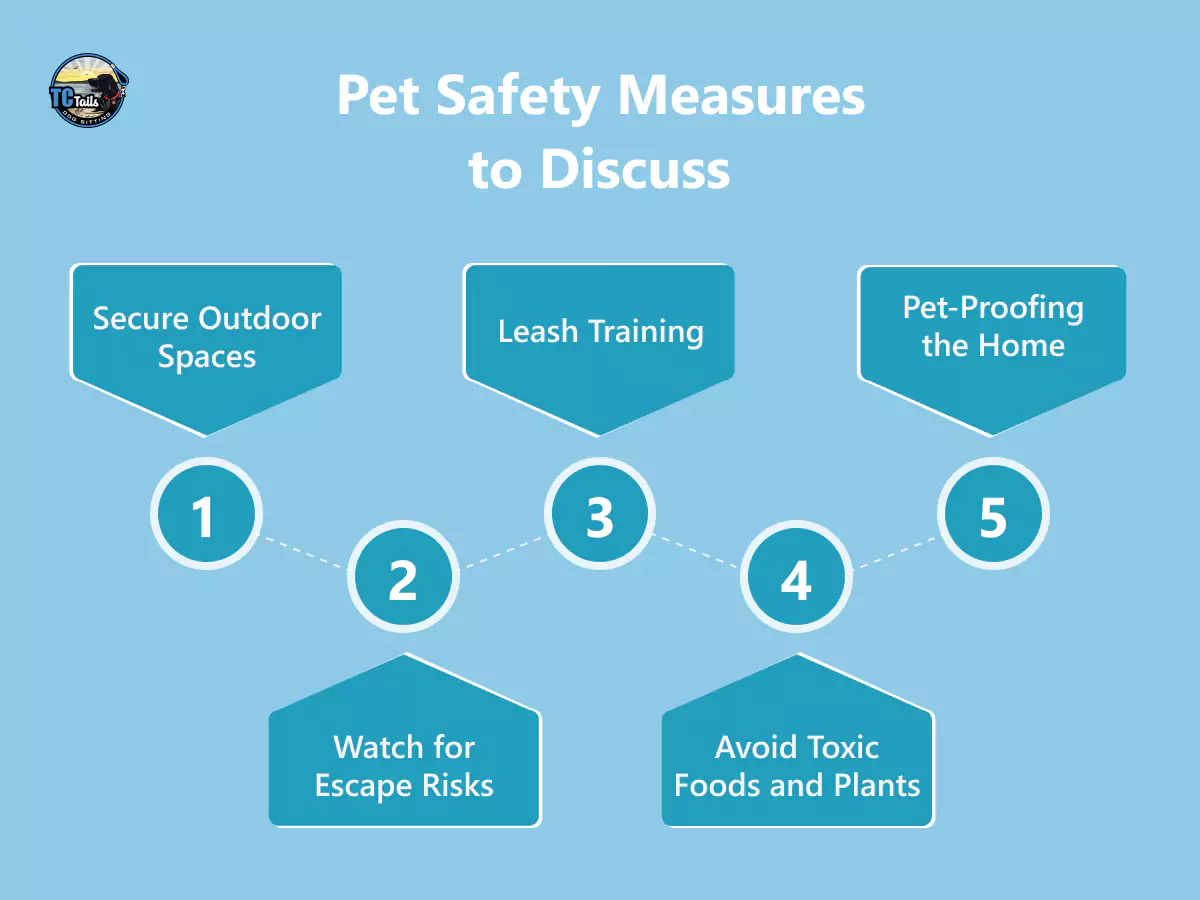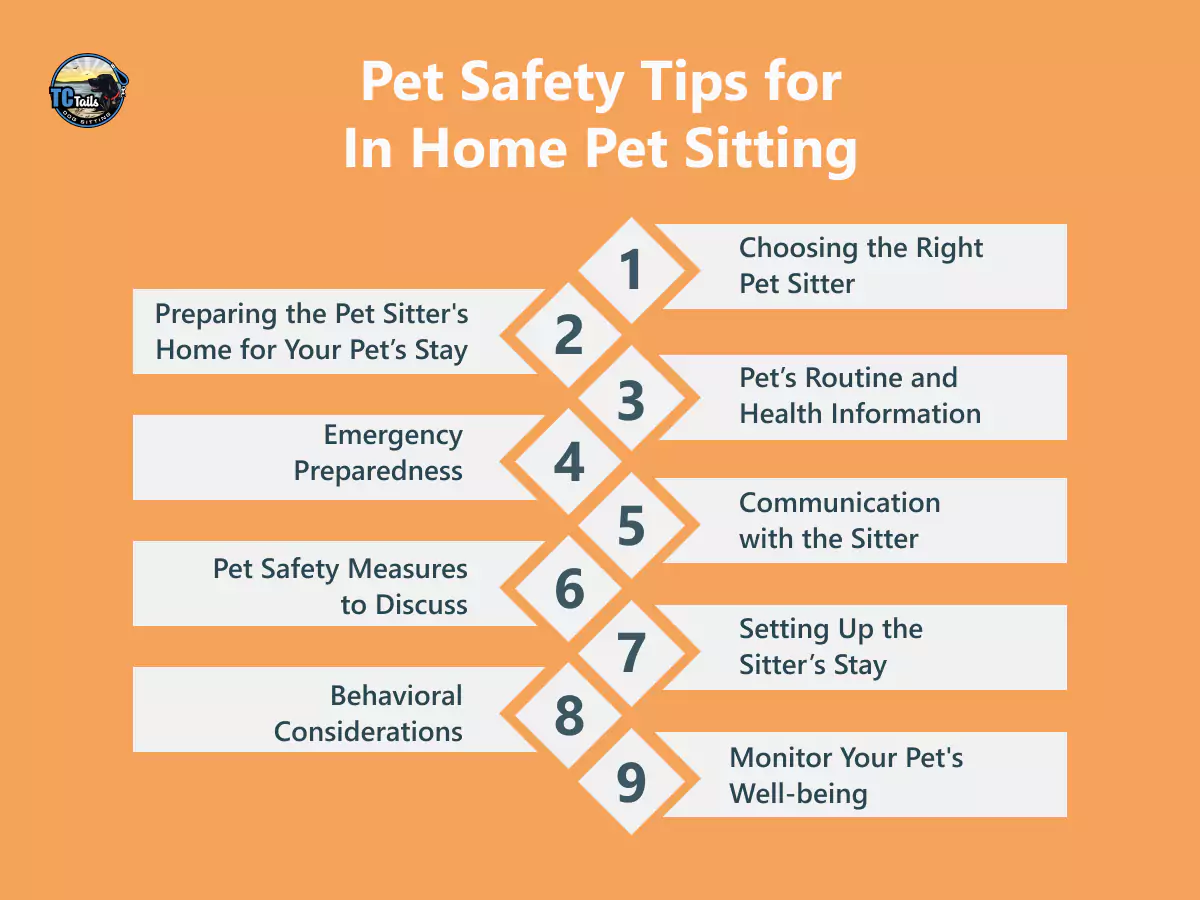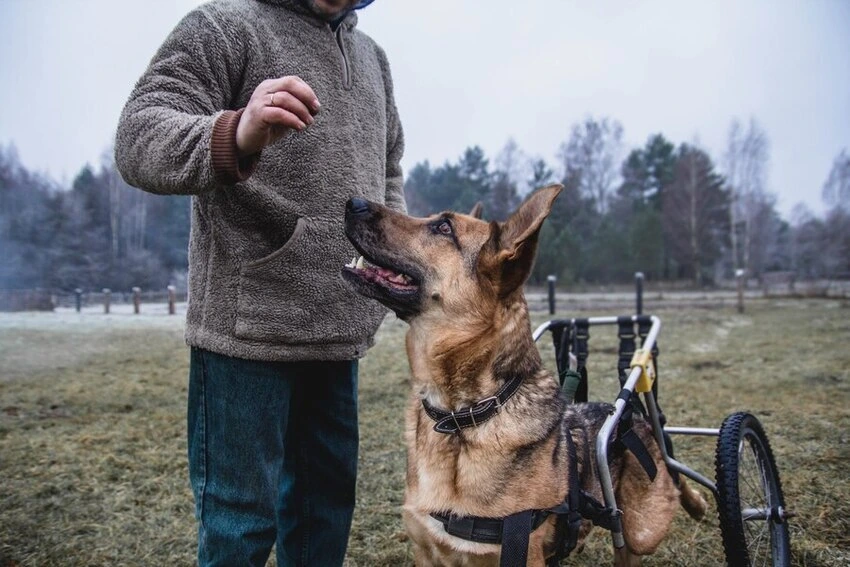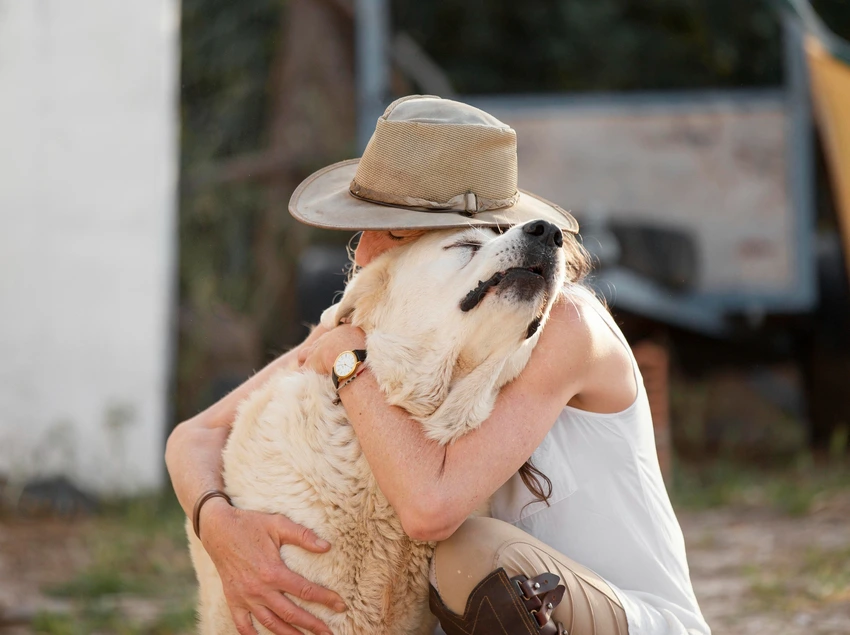When you’re away from home, ensuring your pet’s safety and comfort becomes a top priority. In-home pet sitting can provide your furry friend with a familiar environment, which reduces the anxiety and stress they might experience in traditional boarding.
However, ensuring that your pet sitter takes proper precautions is essential for your pet’s well-being.
This guide covers important tips for keeping your pet safe during an in-home sitting experience, from selecting the right sitter to communicating effectively during the stay.
Read More About Creating a Comfortable Environment for Your Pet During In-Home Sitting
Choosing the Right Pet Sitter
Finding a trustworthy, qualified pet sitter is one of the most important aspects of keeping your pet safe. Here’s a more detailed guide to help you select the best person:
- Experience: Choose a sitter with experience handling your specific type of pet (dog, cat, exotic pet). They should be comfortable with your pet’s breed and personality.
- Background Check: Perform a background check, especially if the sitter is someone you don’t know personally. It’s important to verify that they have a clean record.
- References: Ask for and check references from previous clients. A professional sitter should be able to provide you with contact details of people they’ve worked with before.
- Certifications: Some professional pet sitters have certifications in pet first aid or pet care. This can provide extra peace of mind.
- Personality Match: Ensure the sitter’s personality and approach align with your pet’s temperament. If your pet is particularly shy or energetic, the sitter should be able to adapt.
- Trial Run: Arrange for a short trial visit before the sitting period to observe how the sitter interacts with your pet and see how comfortable they are together.
- Clear Communication: Ensure that the sitter is responsive and willing to maintain an open line of communication, especially during emergencies.
Have questions or need more information? Contact us now to discuss how our pet sitting services can cater to your furry friend’s needs! |
Preparing the Pet Sitter’s Home for Your Pet’s Stay
When you’re preparing to leave your pet with a sitter at their home, there are a few key steps you can take to ensure a safe and comfortable environment for your pet. Here’s what to consider:
- Secure Dangerous Items: Ask the pet sitter to store away harmful items like medications, cleaning agents, sharp objects, and electrical cords. Pets, especially curious ones, can get into dangerous situations if these items are left within reach.
- Pet-Proof the Sitter’s Home: Ensure that the sitter’s home is free from potential hazards. This includes removing breakable items, ensuring windows and balconies are secure, and closing off areas that your pet shouldn’t access or where they might get into trouble.
- Pet Safety Gates: If your pet has specific areas they shouldn’t enter, request that the sitter use pet gates. These barriers can help keep your pet out of rooms or spaces that are unsafe or not pet-friendly.
- Emergency Supplies: Confirm that the pet sitter has easy access to essential first aid supplies such as bandages, antiseptic, and an emergency kit. It’s also a good idea to provide your pet’s specific needs, such as medications, leashes, or harnesses.
- Clean and Pet-Friendly Environment: Ask the sitter to ensure that their home is clean and free of pet-related hazards, such as pet hair or food crumbs that could lead to illness or accidents. A tidy environment ensures both your pet’s and the sitter’s safety.
- Comfort Items: Have the sitter set up your pet’s favorite blanket, toys, or bed in a familiar spot. This will help your pet feel more at ease in the new environment and maintain a sense of security.
By ensuring these precautions, you can help make your pet’s stay at the sitter’s home as comfortable, safe, and stress-free as possible.
Pet’s Routine and Health Information
The more detailed the information you provide, the better the care your pet will receive. Include:
- Feeding Schedule: Clearly outline feeding times, portion sizes, and the type of food your pet requires. Include instructions for special diets or food allergies.
- Medication Details: If your pet is on medication, provide written instructions on dosages, timing, and methods of administration. This is especially important for pets with chronic conditions.
- Medical History: Share any relevant medical history, including recent treatments, surgeries, or conditions that may require attention during the sitting period.
- Behavioral Quirks: If your pet has specific behaviors (e.g., separation anxiety, barking at strangers), make sure the sitter is aware and can manage them effectively.
- Exercise and Play Needs: Outline the amount of physical activity your pet needs daily. If your dog loves to play fetch or your cat enjoys interactive toys, let the sitter know.
- Rest Time: Some pets need more rest or have particular sleep schedules. Share any routine habits or quirks related to their rest time to help the sitter create a peaceful environment.
Read More About Why Pet Sitting Services Are Essential for Your Furry Friends
Emergency Preparedness
Emergencies can arise at any time, so being prepared is essential for both you and your pet sitter:
- Emergency Contact List: Provide a list of important contact information, including your vet, a nearby emergency clinic, and trusted neighbors or friends who can help in a pinch.
- Medical Consent Form: If your pet requires medical treatment, prepare a consent form for the sitter to sign, giving them permission to take your pet to the vet if needed.
- Signs of Illness: Teach your sitter the signs of distress or illness in your pet, such as lethargy, loss of appetite, or unusual behavior. Knowing what to watch for can help prevent a situation from worsening.
- Handling Accidents: Discuss the process for handling accidents (e.g., injuries, vomiting, or poisoning). Ensure the sitter knows how to respond and when to call for help.
- First Aid Knowledge: If possible, provide your sitter with a brief pet first-aid guide, including how to handle cuts, choking, or other injuries until help arrives.
- Lost Pet Protocol: Establish a clear protocol for what to do if your pet gets lost, including checking the neighborhood, contacting local shelters, and using social media to help locate them.
Communication with the Sitter
Effective communication with your pet sitter is critical for a smooth experience:
- Regular Updates: Set clear expectations for how often the sitter should send updates. Whether it’s daily text messages, photos, or videos, regular communication can help keep you calm.
- Urgent Situations: Discuss what constitutes an emergency and how the sitter should reach you in urgent situations. Make sure they have multiple ways of contacting you (email, phone, messaging apps).
- Behavioral Reports: Ask the sitter to report any unusual behaviors or incidents. This helps you monitor your pet’s well-being and address any issues promptly.
- Special Requests: If there are any special instructions or requests (e.g., specific playtime activities or soothing techniques), make sure the sitter is aware of these.
Pet Safety Measures to Discuss

Implementing safety measures is crucial for keeping your pet safe during their time with a sitter:
- Secure Outdoor Spaces: If your pet enjoys spending time outdoors, make sure the yard or garden is fully fenced and the gate is secure. Always supervise outdoor activities.
- Avoid Toxic Foods and Plants: Educate the sitter on foods and plants that are toxic to pets, such as chocolate, grapes, lilies, and certain houseplants. Keep these out of reach.
- Pet-Proofing the Home: Ensure that hazardous areas, like stairways or the kitchen, are off-limits to pets unless supervised. Use baby gates or other barriers where necessary.
- Watch for Escape Risks: Make sure windows, doors, and pet carriers are securely fastened to prevent escapes. This is particularly important if your pet is prone to bolting.
- Leash Training: If your pet is going outside, make sure the sitter is comfortable handling a leash and knows how to properly secure it for walks.
Setting Up the Sitter’s Stay
Setting clear expectations from the beginning is key to a smooth sitting period:
- Arrival and Departure Times: Confirm the sitter’s arrival and departure times well in advance. Provide detailed instructions for accessing your home (e.g., keys, security codes).
- Specific Care Instructions: Give the sitter written instructions on how to care for your pet. This could include feeding, playtime, grooming, and cleaning after your pet.
- Behavior Management: Discuss how the sitter should handle your pet’s behavior, especially if they have issues like barking, chewing, or anxiety.
- Comfort Items: Leave your pet’s bedding, toys, and familiar items in areas where they typically relax. This will help ease any anxiety from being left alone.
| Ensure your dog’s comfort and happiness while you’re away!Book a stay with TC Tails’ professional pet sitters today! |
Behavioral Considerations
Every pet has unique behavior patterns that the sitter should understand:
- Signs of Stress: Explain signs that your pet is stressed or uncomfortable, such as pacing, drooling, or excessive barking. The sitter should know how to calm them down.
- Training Needs: If you’re working on specific training goals, such as house training or leash training, inform the sitter so they can reinforce those lessons.
- Handling Aggression: If your pet is prone to aggression, provide guidance on how to handle these situations, including when to intervene or seek professional help.
- Separation Anxiety: Many pets experience separation anxiety when their owners are away. Discuss how to help your pet cope, such as by providing them with soothing music or a favorite blanket.
Monitor Your Pet’s Well-being
Even though you’re away, staying connected is important:
- Health Updates: Ask the sitter to report any changes in your pet’s health, such as loss of appetite, lethargy, or behavioral changes.
- Daily Check-ins: Request daily updates on how your pet is doing, including their eating habits, energy level, and mood.
- Adjustments to Care: If your pet experiences any issues during the stay, discuss how the sitter should adjust their routine to meet your pet’s needs (e.g., more frequent walks, special food).
- Emergency Follow-ups: If an emergency occurs, ensure the sitter provides you with updates after the fact. Follow up with your vet or another professional as needed.
Conclusion
Choosing in-home pet sitting can be a safe and comfortable option for your pet, but proper preparation is essential for a successful experience. By following these detailed pet safety tips, you can ensure your furry friend receives the best care possible while you’re away. Stay in touch with your sitter, make sure they’re well-prepared, and ensure your home is pet-friendly to give both you and your pet peace of mind. For the best experience and professional care, contact TC Tails for top-notch pet boarding services that ensure your pet is happy, healthy, and safe while you’re away.
FAQs
How do I ensure my pet stays entertained and active while I’m away?
To keep your pet engaged and active, provide the sitter with a variety of toys, puzzles, and enrichment activities. If your pet is highly energetic, discuss an appropriate exercise routine with the sitter, including daily walks or playtime. If possible, provide them with interactive toys that can keep your pet mentally stimulated.
What should I do if my pet sitter has a problem or emergency during the stay?
If the sitter encounters a problem or emergency, ensure they have a list of emergency contacts, including your veterinarian, a local emergency animal hospital, and yourself. It’s also a good idea to provide them with a plan of action, such as where to take your pet in case of a medical emergency or how to manage a behavioral issue.
Can my pet sitter travel with my pet if needed?
If your pet sitter needs to travel with your pet for a walk, vet visit, or any other reason, it’s essential to discuss this beforehand. Some pet sitters may be open to traveling with pets, while others may prefer to keep the sitting experience within the confines of your home. Always check with your sitter and ensure they have a vehicle that’s suitable for transporting your pet safely.
Can I hire a pet sitter for just a few hours or do they need to stay overnight?
Many pet sitters offer flexible options, including hourly visits, drop-in services, or overnight stays. If you only need short-term care for your pet, discuss this with your sitter. Some pets do better with multiple visits throughout the day rather than an overnight stay, depending on their needs.




